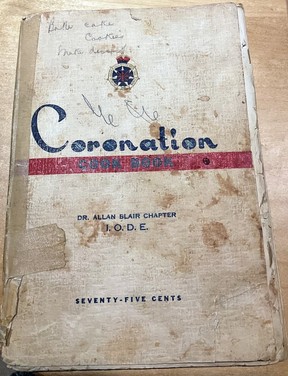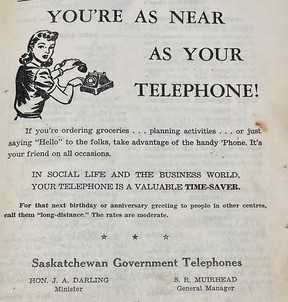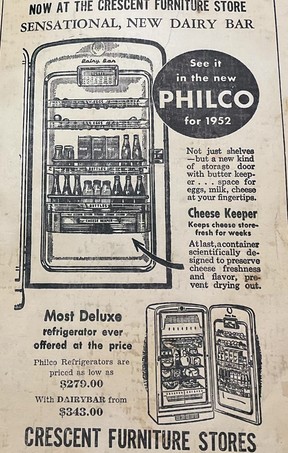Article content
With Christmas approaching, I was searching for the recipe for some cookies that my mother used to make and stumbled across a (literally) battered cookbook published in 1951.

The recipes and ads in a fundraising cookbook provide a bit of nostalgia and perhaps cooking advice as grocery prices soar

With Christmas approaching, I was searching for the recipe for some cookies that my mother used to make and stumbled across a (literally) battered cookbook published in 1951.
My mother was a new bride that year, married during a blizzard on Dec. 15 only a few weeks after having been advised by the Regina school board’s decree that if she married, she would have to resign as a teacher at the end of the school year.
The Coronation Cook Book was almost certainly a gift received at a kitchen-themed bridal shower. And it was a welcome one because Mom embarked on marriage completely uneducated in cooking.
Produced by the Regina chapter of the Imperial Order of the Daughters of the Empire, the price is boldly printed on the cover. Seventy-Five Cents. Scrawled in pencil at the top is “Batter cake Cookies Make dessert.” Mom also inked in the O’s and A’s in Coronation title.

It was a fundraiser with members contributing recipes, which accounts for multiples of favourites like shortbread. The contributors divide into wives designated by Mrs. often followed by their husbands’ first as well as last names and the others, branded by Miss.
Splodges of something dot a page that includes a recipe for “Strawberries.” It’s a no-cook confection of Jello, “dessicated” coconut, condensed milk and lemon flavouring. Pretty enough on a tray of dainties at tea party, I recall having tasted the “strawberries” as a small girl. I may never forget the taste — and not in a good way.
Held together now with masking tape, the soft-cover book almost naturally falls opens at page 28. There, my mother ticked off in pen the long list of ingredients as she added them to the Christmas cake.
More than seven decades, many of the recipes have a renewed appeal to a mid-pandemic population that’s reverted to bread-making and penny-pinching.
There are recipes for scones, rhubarb and apricot conserves, marmalade and Icelandic head cheese. Miss Edna Larmour’s recipe for apple cider notes that it “improves if kept for a few months.” Mrs. K.M. Johnson provides instruction on how to can beans — green beans, I’m assuming, but she isn’t clear.
But there are also plenty of mid-century ‘modern’ recipes including a litany of jellied salads for luncheons and suppers. Lime Jell-O with olives and cashews! Lemon Jell-O with pineapple juice, onions, vinegar, cream and paprika!
Condensed tomato soup is the title ingredient of a cake with nuts, raisins, cinnamon, cloves, allspice and nutmeg with a rum-flavoured icing, while canned soup, canned salmon and “tuna fish” play leading roles in at least a dozen others.
Graham wafers are another favoured ingredient. Miss Claire M. Blanchfield’s Food for the Gods bakes them with dates, walnuts and eggs — “The number depends on the size of the eggs you use. Judge by consistency of batter when additional wafers are required.”
Mrs. D. Weaver takes simplicity a step further in “Delicious Uncooked Cake” that blends the wafers with condensed milk, marshmallows and maraschino cherries.
There’s no doubt Mom’s cookbook was well-used and kept handy. She wrote Grandma’s shortbread recipe on the inside cover and pencilled in a confection that we loved as kids on the blank page that followed.
Crunch up 22 Dad’s Cookies, bake them with butter in a cake pan. Cool and spread melted chocolate over top and sprinkle with walnuts.
The Canadian factory that produced Dad’s Cookies from the mid-1960s until 1984 was in White City, which is now virtually a suburb of Regina. There, thrifty housewives bought imperfects and brokens for the half price or less.
The ads on the cookbook’s odd-numbered pages widen the gaze back to the time when a good number of Baby Boomers were still a twinkle in many young couples’ eyes.
There were still women named Gertie, including one whose flower shop “wired” flowers all over the world, and Mabel who owned a namesake “Smart Millinery Salon.” Men’s clothing stores were still known as hatters and haberdashers.
But the world was changing.

Telephones and a reliable supply of electricity to rural areas were two of the promises that had brought Tommy Douglas and his Co-operative Commonwealth Federation government to power in 1944 and kept them there until 1964. The telephone ad names the Crown corporation’s minister and its general manager.
In the Saskatchewan Government Telephone’s ad, a young woman holds the handset of a rotary-dial phone with her hair was set in a way that suggested that she might have gone to Phillips’ for Beauty where “prot-n-ized cream permanents” were only $4.99 and no appointment was necessary.
“If you’re ordering groceries … planning activities … or just saying ‘Hello’ to the folks, take advantage of the handy ‘Phone,” the ad says. “It’s your friend on all occasions. … For that next birthday or anniversary greeting to people in other centres, call them ‘long-distance.’”

Crescent Furniture’s showed the “SENSATIONAL, NEW DAIRY BAR — not just shelves but a new kind of storage door” on the 1952 Philco refrigerator, the “Most Deluxe refrigerator ever offered at this price.” At $343, its price was nearly $3,700 in 2022 dollars.
“WOMEN WANTED!” Andy’s Electric countered with its “all-new Gurney electric range” described as having “more beauty, more features, more efficiency, more for your money.”
I never did find the recipe I was looking for. Instead, I found a time capsule.
Source: vancouversun.com